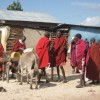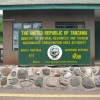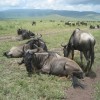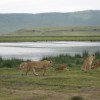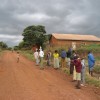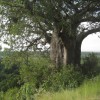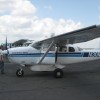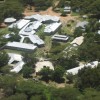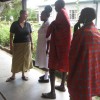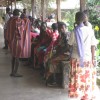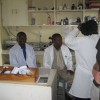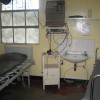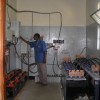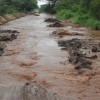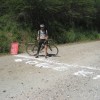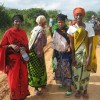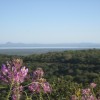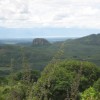TANZANIA travel report (1): day 61 to 69
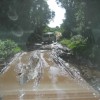 verflowing the road, and sometimes flowing down the road. Stuck trucks, unbelievable up and downhill sections so muddy and slippery that you wondered how any car could pass through. Moreover, this was a day we had to go into hilly country, the total vertical was1400m with camp at a height of 1485m. Just before Bereko, after 101km, our trucks could not go any further as stuck trucks were blocking the way. We all had to backtrack a few kilometres for camp instead of the planned camp a few kilometres beyond Bereko. This after another major thunder/rain storm in the afternoon which most of us could sit out in a little café. A few unlucky, slower riders were caught in the middle of the storm.
verflowing the road, and sometimes flowing down the road. Stuck trucks, unbelievable up and downhill sections so muddy and slippery that you wondered how any car could pass through. Moreover, this was a day we had to go into hilly country, the total vertical was1400m with camp at a height of 1485m. Just before Bereko, after 101km, our trucks could not go any further as stuck trucks were blocking the way. We all had to backtrack a few kilometres for camp instead of the planned camp a few kilometres beyond Bereko. This after another major thunder/rain storm in the afternoon which most of us could sit out in a little café. A few unlucky, slower riders were caught in the middle of the storm.Mar20 The next morning looked like a reasonable day and sure enough around noon the clouds cleared. But not the road!! If anything it was worse than the day before with some sections impassable even for bikes, and for sections walking was the only way to get through with thick red clay attaching itself to the wheels and feet. This day turned out to be even harder then the previous one with total vertical at 1100m and a distance of 108km. The trucks were not in before dark.
Waiting for them we had drinks, omelettes, oranges, bananas as we sat outside a local café in the by now, pleasant night. I worked, in the dark, on my derailleur which throughout the day became very hard to operate. Cleaning the cables and applying some waxy chain lube luckily did the job. Around 10 pm we made camp just outside the town, everything wet and smelly from the previous evening and the past day. However, the troubles were not over! Two bicycles had been stolen in the dark which we only noticed when we left for camp. Police and "buy-back" payments did retrieve them after midnight, luckily for the owners.
Mar21 Day 68 promised to be a beautiful day and this became true. Day 4 on our way from Arusha to Dodoma, 4 days in the same smelly, dirty clothes. I'm sure we smelled worse than some of the characters we passed on the road. The sun shone, wet clothes and shoes dried soon and the 133km to a nice hotel/campsite worked as a stimulant to cover the distance.
The view from the top of the hills was beautiful, lush green plains, green-blue hills further away and a deep blue sky with fluffy white clouds to top it all. After close to 7 hrs of cycling over dirt roads, I got to the hotel and took luxury of a room with toilet and shower. There were many things to be done though: de-mudding the bike, making the shift system work properly again, washing endless red mud out of the cycling clothes I used these four days, drying the tent and other wet things, fix the two tubes that flatted previous day, write the day logs, have dinner and later a beer in the bar, shower and shave, tend the wounds on my right leg which are finally healing just fine. It was 11:30 pm when I finally put the lights out for a sleep of 6 hrs, because the alarm went at 5:30 am. Needless to say that my body once we started riding at 7:30 am my body did not cooperate. I took it easy until, after about half an hour, things were warmed up, the wet cycling clothes, I had washed the day before, dried out, and then I started moving at a good pace along the dirt road helped by the reasonable condition of the road and because it was overall downhill. Two more days to Iringa with the promise of another nice hotel/campsite and a rest day.
Mar22 As I write this on my laptop after dinner in the dark in my tent we are 90km south of Dodoma two riding days away from Iringa. It was a beautiful day with a temperature of 200 Celsius in the morning and hitting 400 at noon when I finished the 90km ride. Overall we descended from 1100m in Arusha to 750m where our camp is and that makes for a fast ride, especially as the roads were reasonable passable for bicycles. The two trucks had a more difficult time at it due to all the deep holes and were much slower than most cyclists. Today for the first time there were plenty of Baobab trees along our way, easily distinguishable due to their massive trunks. I pitched my tent under one for the shade. Among the many people that stand around our camp watching our every move and activity was a teacher who spoke reasonable English. He teaches at a school of 650 pupils with 9 teachers, about 72 students per teacher!
Another camping tip
In Arusha we camped at the Maasai Camping, a well known place locally with all the amenities you could wish for when you must pitch your tent somewhere. A good restaurant, showers with warm and cold water, toilets, good place to sit when you have enough of the tent for awhile and most important, everything is kept clean. The campgrounds offer space, grass and lots of space. No monkeys, no thorns, so what could go wrong then?..........TERMITES! Two of our riders had set up their tents on what later turned out to be termite nests, underground, with only a little telltale hole to mark the entry. Andy had set up his tent after a three day safari to the Serengetti and Ngorongoro parks, glad to get some sleep after this physically and mentally taxing trip. Early in the morning he was awakened by a bite. Investigation showed it to be from a rather large ant also called a termite. Further investigation turned up more termites in his sleeping bag, a whole nest of them in his foam sleeping pad and worse, they had nibbled their way through the ground sheet of his tent. Holding it up against the sunlight later that day it looked as if a hunter had emptied his double barrelled shotgun through the bottom of his tent. African camping lesson 3: before setting up your tent under this nice thornless and monkeyless tree, also check the ground carefully for the telltale holes of underground termite (and ant) nests.
TANZANIA travel report (2): dag 63, Specialreport on Wasso Hospital
- Created on Thursday, 15 March 2007 13:52
- Written by Jan Eisenloeffel
It is beautiful weather and after a fantastic flight of 75 minutes, among other things over a still active volcano near Lake Natron where we could smell the sulphur fumes, we skim over the hill behind the village and the shiny roofs of the hospital. From the sky we look down at the village where at that moment the two-weekly Maasai market is being held.
With a Landcruiser we drive to the hospital where Claar gives us a warm welcome. Just this week Lennard has to be in the Netherlands, a pity I can't meet him. The first impression of the hospital is very good. The buildings look new, everything nicely painted, the surroundings well kept (done by local inmates in orange overalls), the wards spick and span. However, when Claar shows us around it becomes clear that for a hospital necessary things are missing. The place is packed with Maasai people who combine a trip to the market with a visit to the doctor. They don't mind that we are taking pictures, and later on when we visit the market it is not a problem either. Quite the contrary of what we are used to. The Maasai people in their traditional dress make a rich, colourful impression.
After a late, but delicious lunch Ezra wants to go back so we could land before dark. The return flight is even more spectacular. We fly back over Lake Natron. The lake owes its name to the contents of the volcano we flew over this morning. The water is saturated with minerals and other things of the innards of the earth. At the moment there is a lot of water in the lake, but in a couple of months it will be nearly dry and then, according to our pilot, it will have an extraterrestrial appearance. We fly low, some dozens of metres above the water and the mudflats on which we see ostriches, wildebeests, zebra's, a few giraffes, and various birds. And, as an extra just before landing we see the snow-covered Kilimanjaro in the twilight.
After this visit to the Wasso hospital I am more than ever convinced that supporting this so necessary energy project a worthwhile cause is. On our way up I told Ezra that so far I got only about 1200 euros sponsored to which he answered it should be used to let Claar and Lennard stay for another year. Since they arrived at the hospital the level of care is better than ever. Their heart is in it, even though the circumstances are difficult and often frustrating. They couldn't get a bigger compliment from an outsider who also travels to other hospitals.
The energy project, of which there is more to read at the website, has a budget of US$ 100.000. An application, for US$ 70.000, has been made with a NGO which has money available for the project. I hope, through my cycling expedition, to bring in the remaining US$ 30.000. PLEASE, HELP ME TO REACH MY GOAL! I have cycled 6000km without missing a day, often under difficult and very hard circumstances and hope to finish the next 6000km.
Be generous, reward my effort!
FIETSEN VOOR NIEUWE ACCU'S!
Gemaakt op woensdag 18 april 2007
Geschreven door Lennard en Claar
Beste fietsers!
Nu de fietsen al geolied worden en al vele oefenkilometers achter de rug zijn, is het weer even tijd voor een korte update uit de bush.
Half maart hadden we bezoek van dhr Jan Eisenloeffel, die iets meer dan 12000km aan het fietsen is, nl van Cairo naar Kaapstad en op die manier ook zijn spieren en zweet inzet voor meer energie voor ons ziekenhuis.
Financieel ziet het plaatje er nu als volgt uit:
- Jan en de Elfstedenfietsers fietsen voor de nieuwe Varta accu's. De beste accu's ter wereld voor zonne-energie systemen, met de langste houdbaarheid. We hebben al een setje staan in Wasso (zie foto), maar hebben nog 3 extra setjes nodig, om op die manier alle nieuwe lab, zuurstof en andere apparaten van het ziekenhuis van energie te voorzien. Totale kosten van de accu's = 3 x 12.000 euro = 36.000 euro + acessoires (monitors, frames, etc) streef bedrag 40.000 euro.
- De overige kosten voor de uitbereiding van ons electriciteitsnetwerk (stand alone system in the bush) zal gefinancierd worden door de Elisabeth Glasier peadiatric Aids foundation en nog wat andere sponsoren.
- De accu's vormen dus de kern van ons systeem, waaruit voor zo'n 20 jaar energie getrokken gaat worden!
Veel sterkte met de laatste voorbereidingen!
Groeten uit de bush!
Lennard en Claar
TANZANIA travel report (3): day 70 to 73
- Created on Monday, 26 March 2007 12:54
- Written by Jan Eisenloeffel
Lucky enough we had no more rain, the roads dried up quickly and the mud has been sparse.
Mar23-24 Day 70 has been a fairly flat one with only 500m vertical. This day we also passed the 6000km milestone with, as an extra, mangoes, watermelon and an orange for lunch. The next day to Iringa has been much more challenging for my two gear system as we have to climb a mountain range to the 1500m high plain on which Iringa lies. I had good legs this day and sped up the winding road in my two gears, relishing the beautiful views while navigating around the bumps, rocks, loose gravel, muddy places that make up the road. After 4 hrs and 23 min., with an average speed of 18 k/h, I arrived at the hotel/campsite in Iringa. I treated myself to a hotel room with shower and toilet.
Mar25 The "rest day" has been spent on an attempt to get the right shift/brake handle to work and with success! The thing works like a charm. A lot of soaking, suds, water and patience did the job of removing most of the accumulated sand and grime from the internal mechanism. A new inner cable and replacement of the outer cable at the back derailleur have been the finishing touch. As we will be mostly cycling on good asphalt roads from here on I also changed the sprocket set, the small 38 tooth chain ring, the chain, the handle bar tape and of course removed all the mud that was caked all over. What a rest day!! I also had to do the laundry, write website reports, choose photos and reduce the size for the website, and look after getting three good meals. It was 23:30 hrs before I get to sleep!
Mar26 Again a fine day and the work of the previous day paid off. I came in third over the finish line. It was a pleasure to cycle over good roads on a fine bike in good weather that was like a nice Dutch summer day: temperatures of 18C at the start and 24C at the finish at noon. We climbed to a height of 1700m, and the evening as I am writing this, is cold! I put on my long pants, socks and rain jacket to keep warm in the dark, in the vestibule of my tent.
TANZANIA travel report (4): day 74 to 76
- Created on Thursday, 29 March 2007 12:55
- Written by Jan Eisenloeffel
Mar27-28 Our last full days in Tanzania. Today (Tuesday) we had to dip down from an altitude of 1700m to 1100m, which the next day, when we end up in Uyole, we have to regain. Because of the altitude the temperatures remain in the mid twenties. The landscape and roads remind me of tours I make in the Belgian Ardennes. Before our lunch stop on Wednesday I started to feel shivery and listless. I did finish the ride to Uyole where I arrived pooped. We camped at Stockholm Hotel/Campsite and I was lucky to be able to get a room and went to bed immediately. Apparently I have caught an urinary tract infection, started an antibiotics cure that evening, and went to bed early. The next morning, after a night drenched in sweat, I woke up feeling slightly better.
Mar29 We first climbed to 2100m and then descended to the Malawi border at 450m. On our way, still in Tanzania, we had some beautiful views over the northern part of Lake Malawi. I rode at a very slow pace to keep my heart rate down for a speedier recovery. We crossed the border without any problems and 17km into Malawi we set up camp. After 118km and 900m vertical I was exhausted, set up my tent and rested right away. That afternoon and night we got extreme heavy rain. Unfortunately due to my condition, I had to frequently visit the bushes and this became a sopping wet exercise. Around my tent and in the "vestibule" the water covered my toes. My tent though, stayed dry on the inside! Luckily the water drained away pretty fast.

